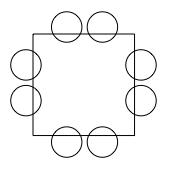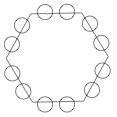Or search by topic
Number and algebra
Geometry and measure
Probability and statistics
Working mathematically
Advanced mathematics
For younger learners
Sitting Round the Party Tables



Sitting Round the Party Tables printable sheet
Some children are at a party. They are sitting around a square table like this:


What do you notice?
You might like to focus on:
- The number of sweets that are given out altogether
- The total number of sweets that children sitting opposite each other are given
- The total number of sweets that children sitting diagonally opposite each other are given
- Or something else!
There are other similar parties happening at the same time. They have bigger square tables with more children sitting around them - perhaps 3 children on each side, or maybe more.
Draw some of these tables. What do you notice? You can choose one of the areas above to focus on, or you might have your own ideas about what to investigate.
Once you've thought about that, you might like to explore what happens with five- and six-sided tables like these:


You may also like
Let's Investigate Triangles
Vincent and Tara are making triangles with the class construction set. They have a pile of strips of different lengths. How many different triangles can they make?

